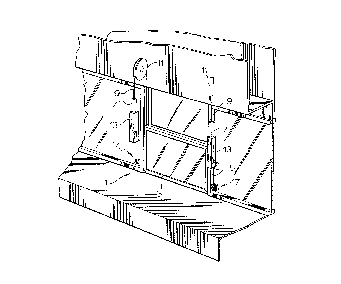Some of the information on this Web page has been provided by external sources. The Government of Canada is not responsible for the accuracy, reliability or currency of the information supplied by external sources. Users wishing to rely upon this information should consult directly with the source of the information. Content provided by external sources is not subject to official languages, privacy and accessibility requirements.
Any discrepancies in the text and image of the Claims and Abstract are due to differing posting times. Text of the Claims and Abstract are posted:
| (12) Patent: | (11) CA 2158772 |
|---|---|
| (54) English Title: | WINDOW ASSEMBLY WITH SAFETY CATCH FOR VERTICALLY SLIDING SASH |
| (54) French Title: | FENETRE AVEC SURETE POUR CHASSIS COULISSANT VERTICALEMENT |
| Status: | Expired and beyond the Period of Reversal |
| (51) International Patent Classification (IPC): |
|
|---|---|
| (72) Inventors : |
|
| (73) Owners : |
|
| (71) Applicants : |
|
| (74) Agent: | DENNISON ASSOCIATES |
| (74) Associate agent: | |
| (45) Issued: | 1999-01-12 |
| (22) Filed Date: | 1995-09-21 |
| (41) Open to Public Inspection: | 1997-03-22 |
| Examination requested: | 1996-09-18 |
| Availability of licence: | N/A |
| Dedicated to the Public: | N/A |
| (25) Language of filing: | English |
| Patent Cooperation Treaty (PCT): | No |
|---|
| (30) Application Priority Data: | None |
|---|
A window assembly with a safety catch comprises a
manually movable window sash which normally slides between
a raised and a fully lowered position within a surrounding
window frame. A weight is connected to the sash by a cable
which counter-balances weight of the sash. The safety
catch prevents downward falling of the sash to the fully
lowered position in the event of breakage of the cable.
The safety catch comprises a sash block spaced below the
weight and clear of the sash when the cable is intact and
the weight is positioned to fall if released from the sash
to move the sash block to a blocking position which holds
the sash above its fully lowered position.
La présente invention a pour objet un ensemble de fenêtre avec cran de sûreté comportant un châssis mobile qui normalement coulisse entre une position relevée et une position abaissée à l'intérieur d'un cadre de fenêtre. Un poids est relié au châssis par l'intermédiaire d'un câble pour contre-balancer le poids du châssis. Le cran de sûreté est constitué d'un bloc de jambage qui est positionné en-dessous du poids et qui est maintenu à une certaine distance du châssis tant que le câble est intact; le poids est positionné de manière à retomber sur le bloc de jambage en cas de séparation du châssis, auquel cas le bloc de jambage est déplacé vers une position de blocage dans laquelle il empêche le châssis de tomber en position complètement fermée.
Note: Claims are shown in the official language in which they were submitted.
Note: Descriptions are shown in the official language in which they were submitted.

2024-08-01:As part of the Next Generation Patents (NGP) transition, the Canadian Patents Database (CPD) now contains a more detailed Event History, which replicates the Event Log of our new back-office solution.
Please note that "Inactive:" events refers to events no longer in use in our new back-office solution.
For a clearer understanding of the status of the application/patent presented on this page, the site Disclaimer , as well as the definitions for Patent , Event History , Maintenance Fee and Payment History should be consulted.
| Description | Date |
|---|---|
| Inactive: IPC from MCD | 2006-03-11 |
| Time Limit for Reversal Expired | 2002-09-23 |
| Letter Sent | 2001-09-21 |
| Grant by Issuance | 1999-01-12 |
| Inactive: Final fee received | 1998-09-21 |
| Pre-grant | 1998-09-21 |
| Notice of Allowance is Issued | 1998-07-13 |
| Notice of Allowance is Issued | 1998-07-13 |
| Letter Sent | 1998-07-13 |
| Inactive: Status info is complete as of Log entry date | 1998-07-06 |
| Inactive: Application prosecuted on TS as of Log entry date | 1998-07-06 |
| Inactive: Approved for allowance (AFA) | 1998-05-25 |
| Application Published (Open to Public Inspection) | 1997-03-22 |
| All Requirements for Examination Determined Compliant | 1996-09-18 |
| Request for Examination Requirements Determined Compliant | 1996-09-18 |
There is no abandonment history.
The last payment was received on 1998-09-09
Note : If the full payment has not been received on or before the date indicated, a further fee may be required which may be one of the following
Patent fees are adjusted on the 1st of January every year. The amounts above are the current amounts if received by December 31 of the current year.
Please refer to the CIPO
Patent Fees
web page to see all current fee amounts.
| Fee Type | Anniversary Year | Due Date | Paid Date |
|---|---|---|---|
| MF (application, 2nd anniv.) - standard | 02 | 1997-09-22 | 1997-07-30 |
| MF (application, 3rd anniv.) - standard | 03 | 1998-09-21 | 1998-09-09 |
| Final fee - standard | 1998-09-21 | ||
| MF (patent, 4th anniv.) - standard | 1999-09-21 | 1999-08-04 | |
| MF (patent, 5th anniv.) - standard | 2000-09-21 | 2000-09-15 |
Note: Records showing the ownership history in alphabetical order.
| Current Owners on Record |
|---|
| ALUMICOR LIMITED |
| Past Owners on Record |
|---|
| DON THOMPSON |
| MIRKO KOVAC |
| TERRY TAM |